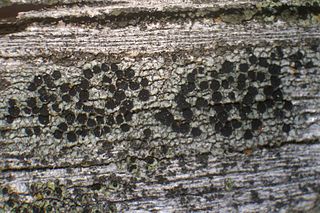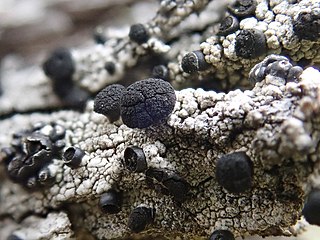
The Arthoniaceae are a family of lichenized, lichenicolous and saprobic fungi in the order Arthoniales. The Arthoniaceae is the largest family of Arthoniales, with around 800 species. Most species in Arthoniaceae belong in Arthonia which is the largest genus with 500 species. The second and third largest genus is Arthothelium with 80 species, and Cryptothecia with 60 species.

Diploschistes is a genus of lichen-forming fungi in the family Graphidaceae. Commonly known as crater lichens, members of the genus are crustose lichens with a thick, cracked (areolate) body (thallus) with worldwide distribution. The fruiting part (apothecia) are immersed in the thick thallus so as to have the appearance of being small "craters". The widespread genus contains about 43 species.

Buellia is a genus of mostly lichen-forming fungi in the family Caliciaceae. The fungi are usually part of a crustose lichen. In this case, the lichen species is given the same name as the fungus. But members may also grow as parasites on lichens (lichenicolous). The algae in the lichen is always a member of the genus Trebouxia.

Acolium is a genus of lichenized fungi in the family Caliciaceae. The genus has a widespread distribution and contains six species. These lichens are found on bark and wood, occasionally on rocks, or growing on other lichens.

Roccella is a genus of 23 species of lichens in the family Roccellaceae. The genus was circumscribed by Swiss botanist Augustin Pyramus de Candolle in 1805, with Roccella fuciformis as the type species.

Felipes is a genus of lichenized fungi in the order Arthoniales. Circumscribed by Andreas Frisch and Göran Thor in 2014, it contains the single species Felipes leucopellaeus. Genetic analysis shows that the genus falls into the order Arthoniales, but its familial placement is uncertain. Felipes leucopellaeus is found across Europe and North America in temperate and boreal regions, typically in old-growth forest or wooded mires. It is crustose and corticolous.

Tylophoron is a genus of lichen-forming fungi in the family Arthoniaceae. The genus was circumscribed in 1862 by the Finnish lichenologist William Nylander.

Immersaria is a genus of lichen-forming fungi in the family Lecideaceae. It has eight species of crustose lichens.
Sprucidea is a genus of four crustose lichens in the family Malmideaceae. Similar to the related genus Malmidea, Sprucidea is characterized by frequently red thalli that contain the secondary compound norsolorinic acid, but differs in the rod-shaped instead of ellipsoid ascospores and in the stalked sporodochia as conidiomata. Sprucidea species are found in rainforest areas in South America and Southeast Asia.
Inoderma is a genus of lichen-forming fungi in the family Arthoniaceae. It was resurrected for use in 2015 for a small group of species with the following features: elevated, white pruinose pycnidia, immersed to adnate white pruinose apothecia, and a weakly gelatinized hymenium. Inoderma byssaceum was assigned as the type species for the genus.
Inoderma sorediatum is a species of crustose lichen in the family Arthoniaceae. It is only known to occur on the bark of trees in Poland's Białowieża National Park. It is differentiated from other species in genus Inoderma by the form of its thallus, which is entirely made of powdery, granular soredia, as well as by the presence of a unique combination of lichen products.
Baidera is a single-species fungal genus in the family Roccellaceae. It contains the species Baidera mauritiana, a corticolous (bark-dwelling), crustose lichen found in Mauritius. Both the genus and species were described as new to science in 2020 by Paul Diederich and Damien Ernst. The genus name honours Cláudia Baider, curator of the Mauritius Herbarium.
Galbinothrix is a fungal genus in the family Chrysotrichaceae. It is monotypic, containing the single species Galbinothrix caesiopruinosa, a corticolous (bark-dwelling) lichen.
Neosergipea septoconidiata is a species of corticolous (bark-dwelling) lichen in the family Roccellaceae. It is a unique species of lichen that grows on the bark of trees in the primary forests of Brazil with its bluish-grey thallus and bright orange pycnidia that have a fluffy hyphal surface.
Sporodophoron primorskiense is a little-known species of corticolous (bark-dwelling) lichen in the family Arthoniaceae. It is notable for its distinctive white, thin growth patterns and small sporodochia, or spore-producing structures. The species is named after the Primorsky Krai region in the Russian Far East, where it was first discovered. It has since been recorded in Japan.

Coniocarpon is a genus of lichen-forming fungi in the family Arthoniaceae. It has eight species of corticolous (bark-dwelling) lichens. This genus is distinct for its crystalline orange, red, and purple quinoid pigments in the ascomata that turn purple in potassium hydroxide solution, its colourless, transversely septate ascospores with large apical cells, and its rounded to lirellate ascomata.
Scutaria is a single-species fungal genus in the family Teloschistaceae. It contains the species Scutaria andina, found in South America. The thallus of this lichen has a form that is intermediate between crustose and foliose.

Confluentic acid is an organic compound belonging to the chemical class known as depsides. It serves as a secondary metabolite in certain lichens and plays a role in distinguishing closely related species within the genus Porpidia. In 1899, Friedrich Wilhelm Zopf isolated a compound from Lecidea confluens, which he initially named confluentin and noted for its melting point of 147–148 °C. This substance demonstrated the ability to turn litmus paper red and, when interacting with alkali, decomposed into carbon dioxide and phenol-like compounds. Zopf subsequently revised the chemical formula and melting point of the compound. Siegfried Huneck renamed it confluentinic acid in 1962, characterising it as optically inactive, with distinct colour reactions and solubility properties, and determined its molecular formula as C28H36O8.
Glomerulophoron is a small genus of lichen-forming fungi in the family Arthoniaceae. The genus contains two species of corticolous (bark-dwelling) crustose lichens. It was circumscribed in 2015 by the lichenologists Andreas Frisch, Damien Ertz, and Göran Thor. It was created to contain a single species from Mauritius, G. mauritiae, which was distinct from the similar genus Sporodophoron both genetically and morphologically, in the tightly coiled chains of sporodochial conidia. The genus gained another member in 2024 when the Brazilian species G. confluentisorediatum was added to it. It is distinguished from the type species by the absence of sporodochia.
Eremothecella cyaneoides is a species of foliicolous (leaf-dwelling) lichen in the family Arthoniaceae. Identified as a new species in 2001, it is a distinct species of leaf-dwelling lichen found in Queensland, Australia. This species is marked by its continuous or marginally dispersed, smooth, whitish-grey thallus. It hosts a phycobiont of the genus Phycopeltis, characterised by rectangular cells arranged in radiate rows.










